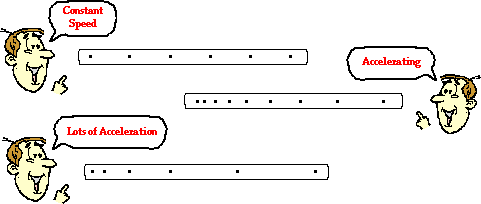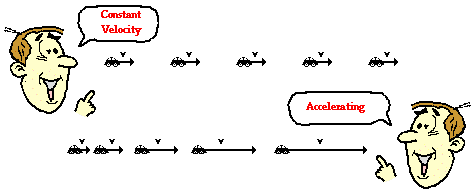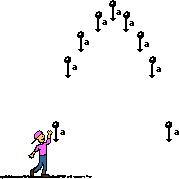Introduction to Diagrams
Begin cultivating your visualization skills early in the course. Spend some time on the rest of Lesson 2, seeking to connect the visuals and graphics with the words and the physical reality. And as you proceed through the remainder of the unit 1 lessons, continue to make these same connections.
Ticker Tape Diagrams
A common way of analyzing the motion of objects in physics labs is to perform a ticker tape analysis. A long tape is attached to a moving object and threaded through a device that places a tick upon the tape at regular intervals of time - say every 0.10 second. As the object moves, it drags the tape through the "ticker," thus leaving a trail of dots. The trail of dots provides a history of the object's motion and therefore a representation of the object's motion.

The distance between dots on a ticker tape represents the object's
position change during that time interval. A large distance between dots
indicates that the object was moving fast during that time interval. A
small distance between dots means the object was moving slow during that
time interval. Ticker tapes for a fast- and slow-moving object are
depicted below.

The analysis of a ticker tape diagram will also reveal if the object is
moving with a constant velocity or accelerating. A changing distance
between dots indicates a changing velocity and thus an acceleration.
A constant distance between dots represents a constant velocity and
therefore no acceleration. Ticker tapes for objects moving with a
constant velocity and with an accelerated motion are shown below.

And so ticker tape diagrams provide one more means of representing various features of the motion of objects.
Check Your Understanding
Ticker tape diagrams are sometimes referred to as oil drop diagrams. Imagine a car with a leaky engine that drips oil at a regular rate. As the car travels through town, it would leave a trace of oil on the street. That trace would reveal information about the motion of the car. Renatta Oyle owns such a car and it leaves a signature of Renatta's motion wherever she goes. Analyze the three traces of Renatta's ventures as shown below. Assume Renatta is traveling from left to right. Describe Renatta's motion characteristics during each section of the diagram.| 1. |
|
| 2. |
|
| 3. |
|
ANS: Renatta moves with a constant speed in the first time interval. She then abruptly decelerates to a stop. She remains at rest for sometime and then moves with a constant speed, slower than the first speed.
Vector Diagrams

In a vector diagram, the magnitude of a vector quantity is represented
by the size of the vector arrow. If the size of the arrow in each
consecutive frame of the vector diagram is the same, then the magnitude
of that vector is constant. The diagrams below depict the velocity of a
car during its motion. In the top diagram, the size of the velocity
vector is constant, so the diagram is depicting a motion of constant
velocity. In the bottom diagram, the size of the velocity vector is
increasing, so the diagram is depicting a motion with increasing
velocity - i.e., an acceleration.

Vector diagrams can be used to represent any vector quantity. In future
studies, vector diagrams will be used to represent a variety of physical
quantities such as acceleration, force, and momentum. Be familiar with
the concept of using a vector arrow to represent the direction and
relative size of a quantity. It will become a very important
representation of an object's motion as we proceed further in our
studies of the physics of motion.

Nice post. Thanks for sharing informative information.
ReplyDeletephysics classroom tutorial